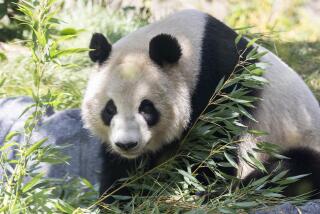How a pair of bald eagles became Southern California rock stars
- Share via
The hottest 24/7 reality show in Southern California right now could be called “The Real Bald Eagles of Big Bear Lake.” As many as 5,000 people at any moment are watching eagles nicknamed Jackie and Shadow on a live-streaming webcam in the mountain town about 100 miles northeast of downtown L.A.
It’s highly addictive — and highly adorable.
For those who haven’t tuned in to the webcam feed posted on YouTube, the camera offers a startling view into the eagle nest 120 feet above the lake in a Jeffrey pine tree. It’s a crisp close-up no human could see from the ground, no matter how powerful the scope.
Currently the nest holds two eggs. By day, you can watch the eagles (Jackie, the female, is the larger of the two) taking turns sitting on the nest, which measures 5 feet across and about 5 feet deep. In the background you can see the blue water of the lake. By night, thanks to an infrared light the birds can’t detect, viewers can watch the somewhat static form of a large white head firmly tucked into its brown feathered body.
Other bald eagles migrate to Big Bear Lake and the surrounding San Bernardino National Forest, and return to their homes farther north. Only these two have become year-round Big Bear Lake residents.

The nonprofit Friends of Big Bear Valley, whose mission is to safeguard the local habitat and the creatures in it, paid about $10,000 to install the camera five years ago, and it’s been a hit ever since. Each year, the organization spends roughly the same amount to upgrade the camera and its solar-powered battery system.
Biologist and executive director Sandy Steers said the webcam serves as a powerful educational tool, one that has attracted the attention of thousands of fans.
“What better way to educate people than to show them what’s going on in the nest?” she asked.
What’s going on in the nest is this: Jackie laid two eggs this month, one on Jan. 8 and a second on Jan. 11. Some dedicated viewers got to witness the events as they happened. The arrival of each egg made local news, including stories in the L.A. Times.
While the eggs are incubating, which takes about 35 days, the area far below the nest, including the Grays Peak Trail and the Grout Bay Picnic Area, has been closed to the public since Dec. 1. Human activity could threaten the eagles and cause them to abandon the nest and the eggs, according to a news release by the San Bernardino National Forest.
Once the chicks hatch, the parents stay close to help feed them and impart hunting skills before the young ones leave the area. It takes five years for eagles to gain the white head and tail, and be ready to mate.
Details that explain the goings-on in the nest day by day are posted on the organization’s Facebook page.
The eggs are expected to hatch around Valentine’s Day. If the chicks thrive, you can expect them to fledge about 10 to 12 weeks later. Last year, two eggs were laid in the nest. However only one chick survived; the other died after six weeks of what was believed to be hypothermia after a late-season storm brought freezing rain and snow over Memorial Day weekend.
The webcam stays live year-round, though the eagles move deeper in the forest in May or June, after their chicks have left the nest for good. The adult eagles typically return to check on the nest in fall.
What has made these birds so popular over the years?
“I think everybody was looking for something positive to be around,” Steers says. “People longed for something to cheer for.”
Info: Friends of Big Bear Valley eagle webcam, friendsofbigbearvalley.org, and Facebook page.
More to Read
Sign up for The Wild
We’ll help you find the best places to hike, bike and run, as well as the perfect silent spots for meditation and yoga.
You may occasionally receive promotional content from the Los Angeles Times.







